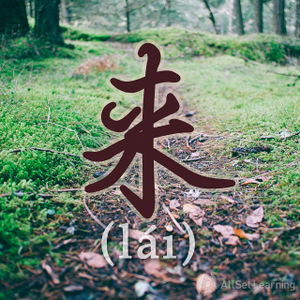Difference between revisions of "Advanced uses of direction complement "-qilai""
m (Text replacement - "yīfú" to "yīfu") |
|||
| Line 20: | Line 20: | ||
<div class="liju"> | <div class="liju"> | ||
*13 和 15 <strong>加</strong> <em>起来</em> 是 多少 ?<span class="pinyin">Shísān hé shíwǔ <strong>jiā</strong> <em>qǐlái</em> shì duōshǎo?</span><span class="trans">How much are 13 and 15 added up?</span> | *13 和 15 <strong>加</strong> <em>起来</em> 是 多少 ?<span class="pinyin">Shísān hé shíwǔ <strong>jiā</strong> <em>qǐlái</em> shì duōshǎo?</span><span class="trans">How much are 13 and 15 added up?</span> | ||
| − | *他 <strong>把</strong> 衣服 都 <strong>收</strong> <em>起来</em> 了 。<span class="pinyin">Tā <strong>bǎ</strong> | + | *他 <strong>把</strong> 衣服 都 <strong>收</strong> <em>起来</em> 了 。<span class="pinyin">Tā <strong>bǎ</strong> yīfu dōu <strong>shōu</strong> <em>qǐlái</em> le.</span><span class="trans">He put away the clothes.</span> |
*我 老婆 <strong>把</strong> 钱 都 <strong>存</strong> <em>起来</em> 了 。<span class="pinyin">Wǒ lǎopó <strong>bǎ</strong> qián dōu <strong>cún</strong> <em>qǐlái</em> le.</span><span class="trans">My wife saves all our money.</span> | *我 老婆 <strong>把</strong> 钱 都 <strong>存</strong> <em>起来</em> 了 。<span class="pinyin">Wǒ lǎopó <strong>bǎ</strong> qián dōu <strong>cún</strong> <em>qǐlái</em> le.</span><span class="trans">My wife saves all our money.</span> | ||
*<strong>把</strong> 你 的 玩具 都 <strong>收</strong> <em>起来</em> 。<span class="pinyin"><strong>bǎ</strong> nǐ de wánjù dōu <strong>shōu</strong> <em>qǐlái</em>.</span><span class="trans">Put your toys away.</span> | *<strong>把</strong> 你 的 玩具 都 <strong>收</strong> <em>起来</em> 。<span class="pinyin"><strong>bǎ</strong> nǐ de wánjù dōu <strong>shōu</strong> <em>qǐlái</em>.</span><span class="trans">Put your toys away.</span> | ||
Revision as of 06:53, 11 December 2020
-
Level
-
Similar to
-
Used for
-
Keywords
We have seen before that 起来 (qǐlái), among other things, can be used to express a literal upward movement. 起来 also has some less intuitive usages, which are figurative extensions of the "movement" idea. For example, 起来 can be used to express collecting things together, sort of like in English we might say "tidy up," or "gather up."
Structure
Verb + 起来
Note that you will often see this pattern used with 把 sentence.
Subj. + 把 + Obj. + Verb + 起来
Examples
These examples are all more literal cases of bringing physical things together is some way.
- 13 和 15 加 起来 是 多少 ?How much are 13 and 15 added up?
- 他 把 衣服 都 收 起来 了 。He put away the clothes.
- 我 老婆 把 钱 都 存 起来 了 。My wife saves all our money.
- 把 你 的 玩具 都 收 起来 。Put your toys away.
- 你 为什么 要 把 我 的 手机 藏 起来 ?Why would you hide my cell phone?
- 你 可以 把 手机 拆开 , 但是 你 能 重新 装 起来 吗 ? You can take the phone apart, but can you put it all back together again?
起来 can also be used to express more abstract concepts of bringing things together.
- 这 两 个 颜色 搭配 起来 很 漂亮 。 These two colors look great when you combine them.
- 如果 我们 团结 起来 ,一定 能 赢 。We will absolutely win this if we band together.
- 如果 你 把 工作 和 兴趣 结合 起来,工作 就 会 很 快乐 。 If you combine your work with your interests, working will be fun.
- 如果 你 能 回忆 起来 这 件 事情,就 好 了。It would be good if you could recall this incident.
See also
- Result complement "-qilai"
- Figurative directional complements 下去 and 出来
- Direction complement
- Result complements "dao" and "jian"
- Appearance with "kanqilai"
Sources and further reading
Books
- HSK Standard Course 4下 (pp. 135) Anything Goes (无所不谈) →buy
- Boya Chinese Elementary Starter 2 (博雅汉语初经起步篇) (pp. 80) Anything Goes (无所不谈) →buy
- Chinese Grammar - Broken down into 100 items - Basic and Intermediate Levels (汉语语法百项讲练 - 初中级) (pp. 25-31) Anything Goes (无所不谈) →buy
- Integrated Chinese: Level 1, Part 2 (3rd ed) (pp. 141-2) Anything Goes (无所不谈) →buy
- Integrated Chinese: Level 2, Part 1 (pp. 342-3) Anything Goes (无所不谈) →buy
- Integrated Chinese: Level 2, Part 2 (pp. 20) Anything Goes (无所不谈) →buy
- New Practical Chinese Reader 3 (新实用汉语课本3) (pp. 169) Anything Goes (无所不谈) →buy
- New Practical Chinese Reader 5 (新实用汉语课本5) (pp. 134-5) Anything Goes (无所不谈) →buy



